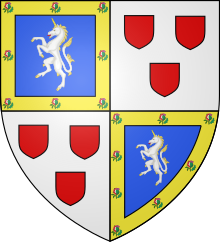|
George Hay, 8th Earl of Kinnoull
George Henry Hay, 8th Earl of Kinnoull FRS (23 June 1689 – 28 July 1758), styled as Viscount Dupplin from 1709 to 1719, was a British peer, Tory politician, and diplomat. BiographyHe was the eldest son of Thomas Hay, 7th Earl of Kinnoull and Elizabeth, daughter of William Drummond, 1st Viscount Strathallan. In 1708, he came under the wing of Robert Harley, 1st Earl of Oxford and Earl Mortimer, whose position was equal to that of prime minister. He married Oxford's daughter in 1709, and his position as his son-in-law proved advantageous. He was a member of the so-called Tory "October Club."[1] In 1710, George Hay became the Member of Parliament for Fowey until 1711. He was created Baron Hay of Pedwardine, Herefordshire on 1711.[2] He was created along with eleven others, who became known as Harley's Dozen, with the aim of supporting the Tory government's peace policy in the previously Whig-dominated Lords. He then became the Teller of the Exchequer between 1711 and 1714. William Bromley wrote, on the occasion of Viscount Dupplin accepting the role in 1711, that he was "so pretty a gentleman, so generally well beloved."[1] He was elected a Fellow of the Royal Society in March 1712.[3] In 1713, he bought Brodsworth Hall, Yorkshire from the Wentworth family and rebuilt the house. During the Jacobite rising of 1715, he was imprisoned in the Tower of London for suspected Jacobite sympathies from 21 September of that year to 24 June 1716.[1] He was accused of conspiracy in the Atterbury Plot of 1722 but a motion for an inquiry failed in the House of Lords, 64 to 29, even though the earl himself voted in favor of the inquiry.[4] He succeeded to the title of 8th Viscount of Dupplin on 5 January 1718/19. On 5 January 1718 he succeeded to the title of 8th Lord Hay of Kinfauns. In 1720, he lost heavily in the South Sea Bubble. The earl was appointed British ambassador to the Ottoman Empire on 16 May 1729. He arrived at Constantinople on 15 April 1730. Recalled on 19 August 1735, he left Turkey in the autumn of 1736. He died in Ashford, Surrey, on 28 July 1758.[1] Marriage and issue He married Harley's elder daughter Abigail around 1 September 1709. They had four sons and six daughters:[5]
References
Further reading
|
||||||||||||||||||||||||||||||||||
